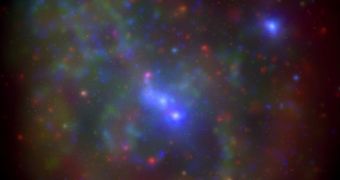Astronomers and astrophysicists around the world could soon have a front row seat to an event that will probably only occur once within our lifetimes – the central black hole in the Milky Way, known as Sagittarius A*, will meet up with a large gas clouds, and consume it altogether.
Gulping up matter from their surroundings is one of the main mechanisms through which black holes feed, but thus far experts have never observed the process as it happens. The NASA Swift satellite is already conducting regular checks of the gas cloud, known as G2, and its trajectory.
When Sagittarius A* starts feeding, it will most likely begin to release high amounts of energetic radiations, particularly in the X-ray and gamma-ray portion of the electromagnetic spectrum. This should make observing it a lot easier than usual, Space reports. How long this collision will last is currently unclear, but it will definitely not happen overnight.
G2 is estimated to be about 12 times more massive than our planet, and could contain a dim star obscured within. However, detecting such an object is nearly impossible with current telescopes. Its demise at the hands of Sagittarius A* may reveal the black hole's boundaries.

 14 DAY TRIAL //
14 DAY TRIAL //